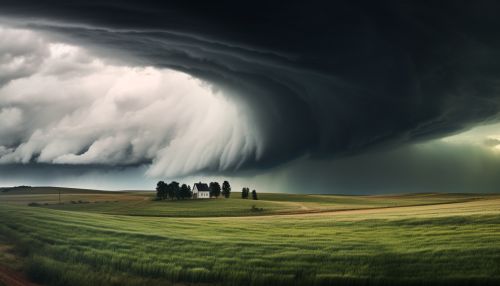Tornado forecasting
Introduction
Tornado forecasting is the science of predicting the occurrence of tornadoes in specific regions and during specific time frames. This discipline is an integral part of meteorology, the broader study of weather patterns and atmospheric phenomena. Tornado forecasting involves the use of various tools and techniques, including radar systems, satellites, and computer models.


History
The history of tornado forecasting dates back to the late 19th century, when meteorologists first began to understand the conditions that lead to tornado formation. However, it was not until the mid-20th century that significant advancements in tornado forecasting were made, largely due to the development of Doppler radar technology.
Meteorological Conditions for Tornado Formation
Tornadoes form under very specific meteorological conditions. They are most commonly associated with severe thunderstorms, particularly those known as supercells, which are characterized by a persistent, rotating updraft. The presence of wind shear, or a change in wind speed and/or direction with height, is also a crucial factor in tornado formation.
Forecasting Methods
Tornado forecasting involves several methods, including observational data, weather radar, weather satellites, and computer models. Each of these methods provides valuable information that meteorologists use to predict the likelihood of tornado formation.
Observational Data
Observational data, such as temperature, humidity, wind speed and direction, and atmospheric pressure, are collected from a variety of sources, including weather stations, aircraft, and balloons equipped with weather instruments known as radiosondes.
Weather Radar
Weather radar is a vital tool in tornado forecasting. It uses radio waves to detect precipitation, as well as the movement and intensity of storms. Doppler radar, a specific type of weather radar, can also detect the velocity of precipitation particles, which allows meteorologists to identify rotation within a storm - a key indicator of potential tornado formation.
Weather Satellites
Weather satellites provide a broad view of weather systems, including their size, location, and movement. They can also detect temperature changes and cloud patterns associated with severe weather, including tornadoes.
Computer Models
Computer models play a crucial role in tornado forecasting. They use complex mathematical equations to simulate the atmosphere and predict future weather conditions. These models take into account a wide range of factors, including temperature, humidity, wind speed and direction, and atmospheric pressure.
Tornado Warning Systems
Once a potential tornado is identified, meteorologists issue a tornado warning to alert the public. These warnings are disseminated through various channels, including television and radio broadcasts, social media, and emergency alert systems. The goal of these warnings is to give people in the path of the tornado enough time to seek shelter and protect themselves from the storm.
Challenges and Future Developments
Despite significant advancements in tornado forecasting, there are still many challenges in this field. Tornadoes are highly complex and unpredictable phenomena, and even with the most sophisticated tools and techniques, it is not always possible to accurately predict when and where they will occur.
Future developments in tornado forecasting may include improvements in radar technology, more accurate computer models, and better understanding of the atmospheric conditions that lead to tornado formation. These advancements could lead to more accurate and timely tornado forecasts, potentially saving lives and reducing property damage.
